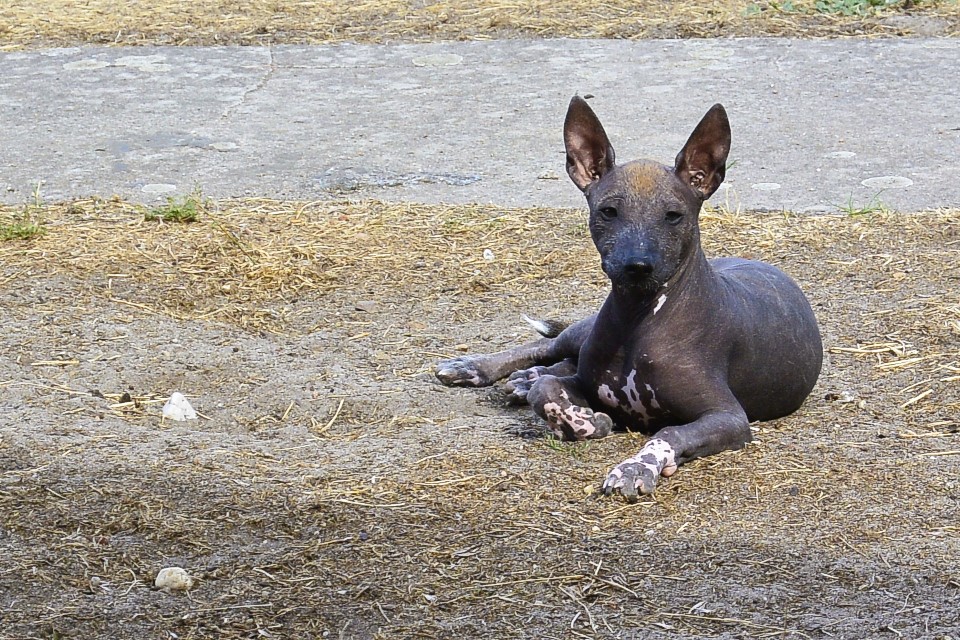Exclusive for zoos.media – originally published in German on the 22nd of December in 2022. Author: Philipp J. Kroiss. Translator: Denis Gautheret
Hairless dogs are among the oldest dog breeds still existing today. The reproach of a “torture breeding” comes up regularly in the discussion of some advocates of their extinction. This is fundamentally wrong.
Ancestral and rare dogs falsely suspected
Dog and wolf: a common ancestor
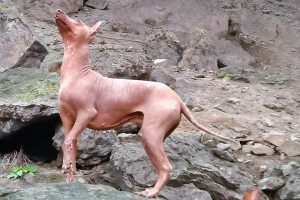
The house dog is the domesticated species in the dog biological family (canidae, canidae), whereas a wolf is a wild animal. Therefore, dogs are not tame wolves and wolves are not wild dogs. From a purely physical standpoint, wolves and the vast majority of dog breeds have virtually nothing in common. The domestic dog and the wolf are very different: there are ethological and socio-ecological differences between them, but also physiological, phenotypic, and genetic differences. Nevertheless, domestic dogs and wolves form a successful natural breeding community, with free choice of spouse, and thus produce fertile offspring.
The claim that the dog is descended from the wolf is often misunderstood and interpreted as if our current domestic dog was derived from the current wolf through domestication. Genetic studies suggest that the modern wolf and the ancestors of the present dog may have come from a common wolf ancestor, now extinct, about 30,000 years ago. To be clear: The dog is no more directly descended from the wolf than man is from the chimpanzee. We too, humans and other great apes, certainly share a common ancestor, without seeking the answer to all existential questions in the primates of the nearest zoo.
Historical representations of prehistoric dogs: from past to present
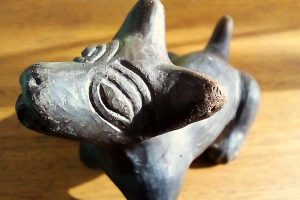
Currently, the oldest dog breed is thought to be the Basenji, which has its roots in Egypt. The breed is thought to be at least 8,000 years old, according to cave murals. It is a very original and difficult-to-interpret form of conservation history.
If we look for primitive dogs on the American continent, we come to the so-called hairless dogs. Here, their oldest representation is the clay figure of a Xoloitzcuintle (pronounced: Scholo-itz-kuint-li), also known as the Mexican hairless dog. This clay figurine is dated to approximately 1,700 years before Christ. It is therefore more than 3,700 years old. Until today, this breed has remained almost unchanged phenotypically, i.e. visually. The same is true for the Perro sin pelo del Perú, the Peruvian Hairless Dog.
The third breed currently alive and recognized by the Fédération Cynologique Internationale (FCI) is the Chinese Crested Dog. Its origin is not yet known with certainty. The hairless dogs were noticed by the great naturalists Carl von Linné, Alexander von Humboldt, and Charles Darwin during their exploration trips. Carl von Linné described these dogs in 1758 in his book “Systema naturae”, while Alexander von Humboldt reported in his “Ansichten der Natur” in 1807 “the large number of hairless black dogs in Quito and Peru”.
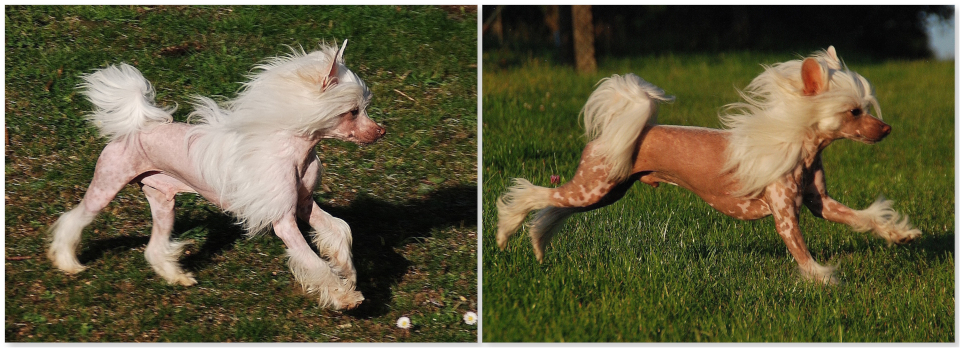
Hairless dogs – with or without hair
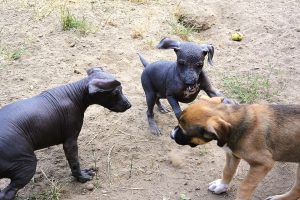
When we think of hairless dogs, we often forget that there are two varieties: the hairless dog without hair and the hairless dog with hair. This sounds contradictory, but it is the reality. They are even found simultaneously in the same litter. It is important to know that no hairless dog is completely hairless, even hairless dogs. Vibrissae, or whiskers, which are important and functional hairs on the head, are normally present in all so-called hairless dogs.
Hair is also regularly found on the upper part of the head, on the tail, and in the foot area. Hairless nude dogs have this in common with us humans: the hairless skin becomes darker in summer and lighter in winter. The dogs’ hairlessness is due to a random genetic mutation that appeared spontaneously already 3,700 years ago. It is the mutation of the gene called FOXI-3, the abbreviation of the Forkead Box I3 gene. This gene is also present in other mammals.
Hairless dogs with special teeth
The FOXI-3 gene is also involved in the development of teeth. Its mutation causes certain teeth to be missing in hairless dogs. These can be incisors, canines and/or premolars, but never molars. However, there is no model to determine concretely which and how many are present in each case. Characteristic dog skeletons discovered from 800 AD onwards – More than 1,200 years ago – show, for example, the absence of molars.
According to the Max Planck Institute for Evolutionary Anthropology, it is quite possible that this gene also played a role in the evolutionary changes in human dental morphology. This dental feature is not a problem for these dogs, which have lived for more than three millennia with fewer teeth than other domestic dogs. Like other domestic dogs, they have a very different life reality than the wolf. Domestic dogs, which receive their food from humans, actually no longer need certain teeth that are vital to the wolf.
If the described peculiarity of the dentition was a problem for the hairless dog, it would certainly have disappeared by now or would be walking around screaming and emaciated. It is well known that this is not the case. They eat as well and as willingly as other dogs. However, animal rights “advocates” and even some official veterinarians blame the dogs for suffering because of this teething feature. Those who know hairless dogs also know from experience that this is not true.
Accusations: absurd and indefensible
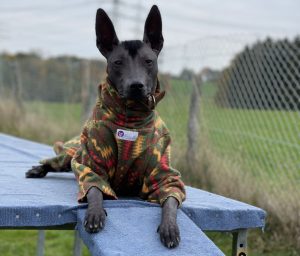
Their particular dentition has obviously sufficed for hairless hairless dogs for millennia. They also live with any thick fur without any problems. Opponents of hairless dogs do not simply assert the absence of teeth and fur without proof. They imply that the animals suffer from this situation. They also make arbitrary claims that these dogs are not capable of thermoregulation, that their immune systems are allegedly impaired, and that the resorption of embryos that occurs is a violation of the animal protection law.
The veterinary doctor Alexandra Doernath is an expert in the field of so-called hairless dogs. She emphasizes: “To say that ‘hairless hairless dogs’ cannot thermoregulate is complete nonsense. An animal would be dead if it could not thermoregulate. A difference of only 2°C has a great influence on the biochemical processes of the body, especially in endotherms. Hairless dogs’ – both hairy and hairless – can therefore also thermoregulate.”
Lethal factor?
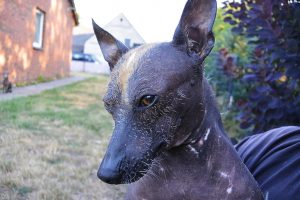
Doernath continues: “The ‘hairless dogs’ regularly reach an advanced age. If they had an immune system defect, this would not be the case. In that case, the animals would not be able to play outside or dig in the ground without getting sick, let alone live that long in good health. The fact that hairless dogs would have a disturbed immune system is nothing more than a scientifically unproven claim”. It is true, according to Doernath, that a lethal factor is present in the three breeds Xoloitzcuintle, Perro sin pelo del Perú, and Chinese Crested Dog. If the FOXI3 gene of the canine embryo carries the H/H alleles, i.e. two alleles for the absence of hair, the embryo in question would be resorbed.
The H/H genotype would be incompatible with life. However, the resorption of fetuses in hairless dogs carrying the H/H gene takes place at an early stage of gestation, the veterinarian points out. Embryonic death of the fetuses, respectively embryonic resorption, is not a violation of the German Animal Protection Act. Doernath points out that this is also mentioned in the expert opinion on the interpretation of § 11b of the Animal Protection Act, published in 2002 by the Federal Ministry for Consumer Protection, Food and Agriculture (BMVEL). In addition, a certain degree of resorption of fetuses is said to be physiological in dogs.
Hairless dogs as breeds and cultural witnesses

The knowledge and needs make it probable that there was a conscious breeding of purebred dogs in the Andes in pre-Columbian times. Between the Spanish conquest of Peru in the 16th century and the rediscovery of the Perro sin pelo del Perú and the Xoloitzcuintle in their native regions and their respect as national dogs in the 20th century, there were dark centuries of contempt and disdain for the breeds. In Mexico, the artist Frida Kahlo played an important role in popularizing the hairless dog again, which had almost disappeared. Modern breeding was then done by selecting lines for the three breeds of hairless dogs recognized by the FCI.
Like all cultural breeds, also called domestic or livestock breeds, the hairless dogs were kept for a certain purpose: as a form of a hot water bottle, e.g. to warm up children and elderly people at night, but also to bring warmth in a targeted way to rheumatic knees. In addition, they were also charged with a religious mission, namely to accompany the deceased into the realm of the dead – the dogs were still alive at first. They also served as food for the men. But today, like many of these cultural breeds, they are simply pets loved and protected by people who are passionate about these particular breeds of dogs and ideally wish to preserve them through breeding.
Preservation of cultural heritage
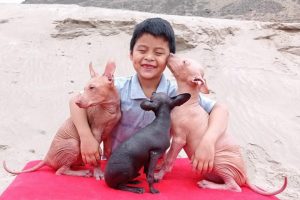
This passion allows us to take a look at the history of dog breeding. This makes the preservation of this breed very interesting and worth supporting. It is with good reason that many animal owners are involved in the care of old breeds, both privately and professionally. These breeds are endangered because they are often no longer in demand for their usefulness – the classic example being the dual-purpose breeds of agriculture.
Hairless dogs are very lucky that they are not yet threatened with extinction, even though they are rare, because different people, without being for example Aztecs with rheumatic joints without a hot water bottle, are passionate about them. However, they are in danger: the dog breeds Xoloitzcuintle, Perro sin pelo del Perú and Chinese Crested Dog are indeed threatened by the populism that resonates against these primitive dogs. It is claimed that these thousand-year-old breeds are “torture” breeds. To attribute such a label to them is a very singular thesis, considering the age of the breed and the typical canine behavior of the very intelligent individuals that compose it.
Millennia of “torture” breeding?
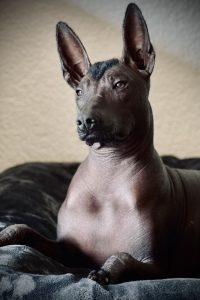
Breeding in the sense of the Animal Protection Act means the zootechnical treatment of animal breeds. The targeted selection and mating of animals should lead to the further development of breeding. For this purpose, the respective breeding objectives, e.g. in dog breeding, the so-called breed standards of the FCI are used. The term “torture breeding” is currently on everyone’s lips. However, it does not appear in the Animal Protection Act. According to Professor Hansjoachim Hackbarth, a veterinary specialist, this term should not be used either, because it implies that the breeder is intentionally cruel to the animals. In addition, “torture breeding” is a non-objective, non-scientific, stigmatizing, not unbiased, and negative term in everyday language that can lead the reader or listener astray.
Indeed, this term could be directly derived from the sensationalist press and therefore has no place in an objective context, as it is evaluative, condemning, and precisely not neutral. To this extent, the subtitle, according to Hackbarth, of the expert opinion published by the BMVEL in July 2002, called “Qualzuchtgutachtens”, on the interpretation of article 11b of the Animal Protection Act, is extremely ill-chosen and leads to polarization. It is interesting to note that no dog expert was part of the group that wrote this expertise for the BMVEL.
Dr. Alexandra Doernath, a hairless dog expert and veterinarian, recommends: “Instead of talking about ‘torture farms’, we should rather talk about ‘paragraph 11b animals’. Doernath is referring to Paragraph 11b of the German Animal Protection Act. “The term ‘Paragraph-11b-Tier’ is neutral, objective, and descriptive. But ‘hairless dogs’ are definitely not animals covered by paragraph 11b. Neither the lack of fur nor the peculiarity of their dentition causes them pain, suffering, or harm. They should therefore not be stigmatized as ‘torture animals’.
Hairless dogs: primitive dogs without deficits
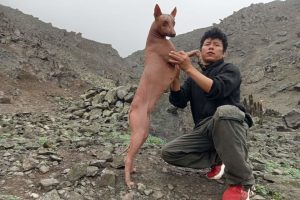
If healthy hairless dogs are observed eating or even communicating within the species, they have no restrictions – Doernath knows this. The veterinarian has observed the behavior of many hairless dogs and conducted clinical examinations. The scientifically trained veterinarian advises the Exotic Dog Breed Club (Germany) and therefore has a comprehensive view of the current health of the so-called hairless dogs organized in the Club: “Hairless dogs” – whether they are hairless or with hair – do not, in principle, have any deficits in their behavior, movement, and anatomical and physiological functions,” explains Doernath.
“The absence of hair and the peculiarities of the dentition are not a handicap for the hairless varieties of the hairless dogs. Feeding, and thus food intake, rapport, social and solitary play, intraspecific communication as well as thermoregulation are not a problem. Those who speak of “breeding hairless dogs under torture” do not know what they are talking about. The breeding of the Xoloitzcuintle, the Perro sin pelo del Perú and the Chinese Crested Dog is in no way a breeding in the sense of § 11b of the German Animal Protection Act or § 10 of the German Animal Protection Ordinance”, emphasizes veterinarian Doernath.
No trace of breeding under suffering
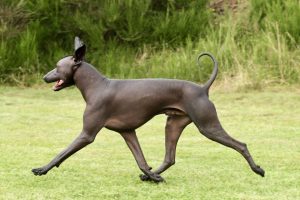
Therefore, it is not possible to certify that hairless nude dogs are bred under suffering conditions. “Unfortunately, the 2002 BMVEL report refers to outdated literature at the time of writing, as well as to references that are not relevant for hairless dogs,” Doernath notes. One of the most sensitive parameters for assessing pain and suffering is the observation of species-specific behavior.
“In principle, individuals of the breeds Xoloitzcuintle, Perro sin pelo del Perú, and Chinese Crested Dog show species-specific behavior typical of domestic dogs. This is especially true for intraspecific social behavior – both within their breed (without distinction between hairless and hairy individuals) and with representatives of other breeds. Intraspecific communication is species-specific and typical of domestic dogs. In the ‘hairless dogs’ I studied and observed, I did not find any signs of suffering, damage, or pain,” explains Doernath.
So the hairless dog does not suffer. Since it is native to warm regions, it is necessary to take the necessary precautions when keeping it in our latitudes. This includes protecting him from sunburn and hypothermia. This can be done with dog clothes, which other breeds, like greyhounds, also need. “The absence of hair in dogs probably has an evolutionary advantage in their natural range,” assumes Doernath, who also values these dogs for their character. She regularly points out that hairless dogs are not fashionable dogs, but precisely primitive dogs. They are not necessarily suitable for inexperienced dog owners.
Dogs do not discriminate among themselves
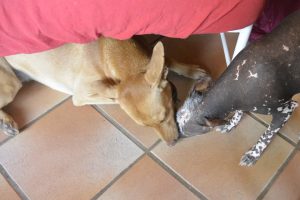
This is why the populist term “torture breeding” is a fundamentally wrong suspicion for these ancestral dogs. On the contrary, these animals have been happy with humans and each other for at least three millennia. Otherwise, it would be impossible to keep such breeds alive for so long. Dogs do not discriminate on the basis of their coat, teeth, or other characteristics.
It is to be hoped that certain interest groups will come to their senses and stop discriminating against these original dogs and their owners. Of course, the suspicion that certain breeds of dogs are bred for suffering and thus prevent their reproduction serves the anti-breeding purposes of the animal rights industry. But that in no way makes this outlandish claim defensible to serious experts like Dr. Alexandra Doernath.
“Let’s hope that these special and fascinating ancestral dogs will be preserved for us. I have seen them in Mexico and elsewhere in their native region, both in the hands of humans and as stray dogs on the street. Peruvians and Mexicans in particular love and revere their ‘hairless dogs’. How can animal rights activists, but also some official veterinarians, afford to call this cultural heritage “torture breeding”? In Latin America, people laugh at those who want to ban these dogs, the ‘Los Alemanes’, i.e. the Germans,” explains Doernath, “Dogs are far ahead of humans: they do not discriminate between members of their own species on the basis of their coat and their teeth. We, humans, have a lot to learn from dogs,” concludes exotic animal vet Doernath with a wink.
